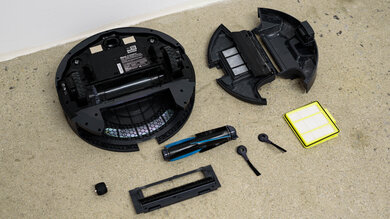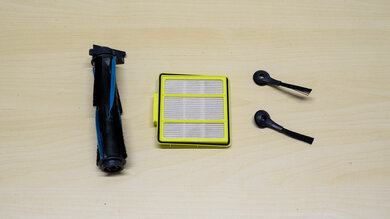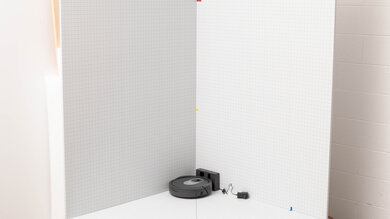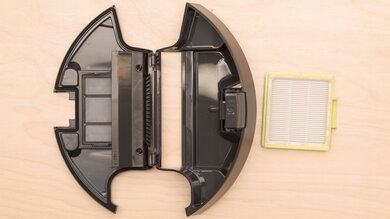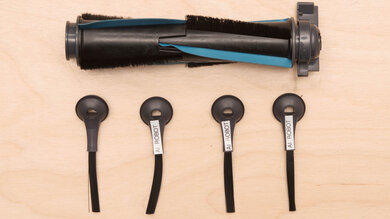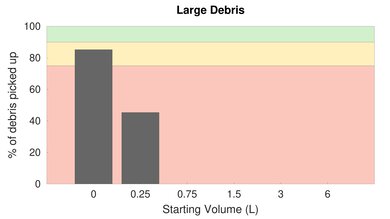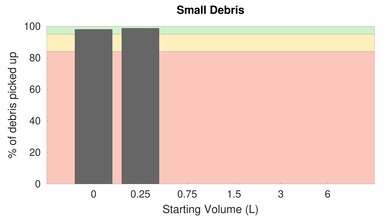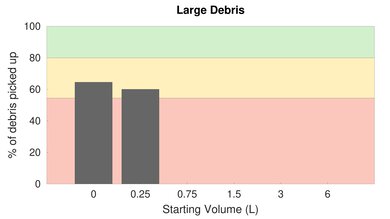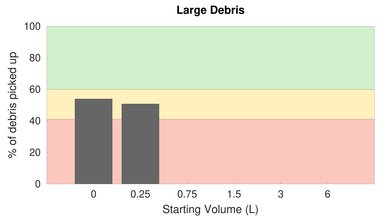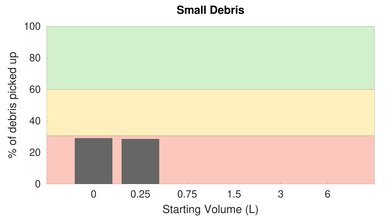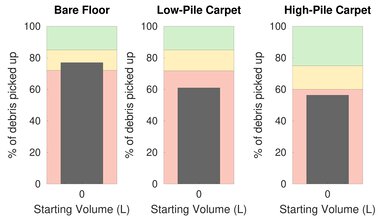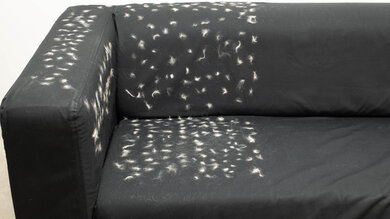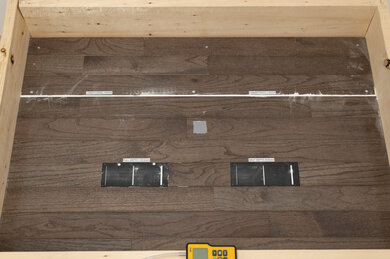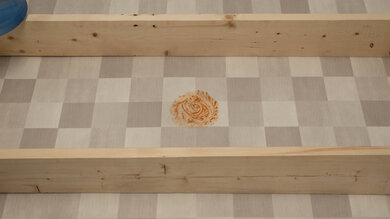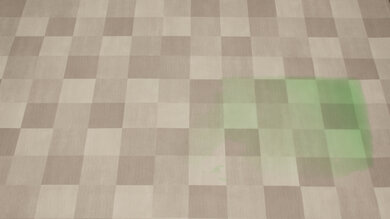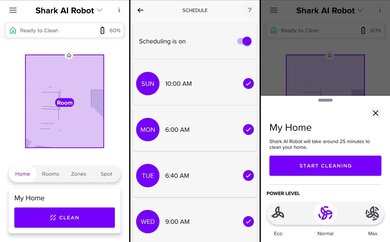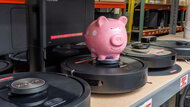The Shark AI Robot is a robot vacuum with relatively advanced automation features. It sits near the middle of Shark's range of robot vacuums, with a relatively sophisticated laser navigation sensor that allows for smart pathing and object avoidance, features not found on the entry-level Shark ION Robot RV700 Series. However, unlike the newer Shark AI Ultra Robot, it doesn't have a LIDAR mapping sensor and isn't compatible with a self-emptying docking station.
Our Verdict
The Shark AI Robot is a satisfactory option for bare floors. It can easily pick up small debris, but pet hair can get caught in the brushroll, and it has trouble clearing bulky debris as the dirt compartment fills up. It also has many parts that need regular cleaning or replacing, so recurring costs can add up over time.
- Easily clears small debris.
- Fantastic battery performance.
- Large debris can get caught in the vacuum's intake opening.
- Pet hair gets caught in the brushroll.
The Shark AI Robot is a mediocre option for low-pile carpet. It can pick up a fair amount of large debris, but it struggles to clear very fine debris. Pet hair can also cling to the brushroll rather than get sucked up. This vacuum also has many parts that need regular cleaning or replacing. Still, it feels well-built and does a great job maneuvering itself. It also has a wide range of automation features.
- Fantastic battery performance.
- Struggles to pick up small debris and pet hair.
The Shark AI Robot is passable for vacuuming high-pile carpet. It does a mediocre job handling solid debris, while pet hair can get stuck on its brushroll. Also, there are quite a few parts that need regular cleaning. On the upside, it's well-built and has great maneuverability. Using its companion app also grants you access to a fairly wide variety of automation functions, though it's worth noting that the app isn't especially user-friendly.
- Fantastic battery performance.
- Sub-par overall performance on high-pile carpet.
The Shark AI Robot is a poor choice for pet owners. Regardless of the surface it's on, pet hair tends to get stuck to its brushroll instead of being sucked into its dirt compartment. It doesn't have an allergen-trapping HEPA filter either, with some fine allergens like pet dander escaping from its exhaust. This vacuum also has many parts that need regular cleaning and incurs high recurring costs. Thankfully, it feels pretty sturdy and operates pretty quietly, which is good if your pet is sensitive to loud noises.
- Pet hair gets caught in the brushroll.
- No HEPA filter.
The Shark AI Robot is a robot vacuum and isn't designed to clean stairs.
The Shark AI Robot is a robot vacuum; you can't use it to clean inside your car.
The Shark AI Robot is a robot vacuum and isn't suitable for workshop cleaning.
Changelog
- Updated Dec 03, 2024:
We've added text to the Airflow box.
- Updated Nov 07, 2023: Converted to Test Bench 0.7.
- Updated Oct 25, 2023: We've added a link to the Shark Matrix Robot in the 'Battery' section to provide an alternative that recharges faster.
- Updated Mar 17, 2023: We've updated the text in the review to account for the new tests and scoring methodology in Vacuum Test Bench 0.5 and Vacuum Test Bench 0.6.
Check Price
Differences Between Sizes And Variants
There are two variants of the Shark AI Robot, though they only differ in terms of included accessories, and we don't expect there to be any notable differences in performance. We tested the RV2001 model, and you can see its label here.
| Model Code | Included Accessories | Color | Notes |
| AV2001 | 4x side brushes, 1x filter | Grey | Updated version of the RV1001 |
| RV2001 | 4x side brushes, 2x filters | Black/Silver |
If you come across another variant of this vacuum that hasn't been mentioned, please let us know in the discussions, and we'll update this review.
Compared To Other Robot vacuums
The Shark AI Robot is a robot vacuum with alright overall performance, sitting squarely in the middle of the vacuum market. Its laser mapping system results in much better maneuverability and faster room mapping than entry-level random-pathing models, which move around your home by bouncing off walls and obstacles. However, it's a little lacking in features compared to newer models with faster LIDAR mapping, compatibility with self-emptying base stations, and, in some cases, mopping attachments.
If you're looking for an alternative, check out our recommendations for the best robot vacuums, the best robot vacuums for carpet, and the best robot vacuums for pet hair.
The Shark AI Ultra Robot is better than the Shark AI Robot. The AI Ultra is self-emptying compatible, does a better job of clearing debris from cracks, performs better on bare floors, has an easier time dealing with pet hair, and has a LIDAR mapping system, which allows for quicker room mapping, even in the dark. Conversely, the AI Robot has fewer parts needing regular cleaning, incurs lower recurring costs, and offers better overall coverage despite its simpler navigation system, as it won't identify everyday objects as hazards to avoid.
The Shark Matrix Robot is better overall than the Shark AI Robot. The Matrix is compatible with a self-emptying base station, delivers better overall debris pickup on a variety of surface types, and recharges faster.
The iRobot Roomba E5 and the Shark AI Robot both have advantages, so one may suit you better than the other, depending on your needs. The iRobot is better built, has fewer parts that need regular cleaning, has an allergen-trapping HEPA filter, and performs slightly better on carpeted surfaces. Conversely, the Shark has a wider array of automation features, maneuvers itself more effectively, clears more debris on bare floors, and incurs lower recurring costs. It also has a much longer battery life, though the iRobot charges substantially faster.
The Shark AI Robot and the iRobot Roomba j7 each have strengths, so one may suit you better than the other, depending on your needs. The Shark incurs lower recurring costs, has a longer maximum battery life, and delivers superior performance on bare floors and low-pile carpets. Meanwhile, the iRobot charges much faster, feels better built, clears more debris on high-pile carpets, maneuvers itself more effectively, and has more advanced automation capabilities, most notably its self-emptying compatibility and hazard recognition feature.
Test Results

The Shark AI Robot feels well-built. Its hard plastic construction has a matte finish, and its main drive wheels have rubber treads. It has a fairly premium appearance and feels quite sturdy overall, though its clear plastic dustbin is a little fragile.
Out-of-the-box assembly is quite simple, requiring only that you snap its two side brushes into place and plug in its docking station.
This vacuum has many parts that need periodic cleaning.
- Dustbin: You can easily remove this part by pressing its release button. An anti-tangle comb is attached to the dustbin to collect any hair that might get sucked in, reducing the chances of hair clogging up the vacuum. However, this plastic comb does take up quite a bit of space and makes it hard to completely clean every last nook and cranny of the dustbin, even after you've emptied it over a trash bin.
- Pre-motor filter: The pre-motor filter is located inside the dirt compartment and can be pulled out by its release tabs. You can tap this part over your garbage to dislodge dirt and dust after each use. You can also rinse it with water once a month if needed.
- Brushroll: You need to remove the brushroll cover underneath the vacuum to access this part. No specific maintenance interval is given by the manufacturer, but make sure to remove any tangled hair or stuck-on debris regularly. The fins on the brushroll aren't especially effective in preventing hair from getting tangled around it, and you'll still probably need to cut away some longer strands with a pair of scissors.
- Side brushes: You can pull the side brushes out of their sockets without the need for any tools. You should check them weekly and clean them as needed by removing hair or debris. You can also wipe them with a damp cloth.
- Drive wheels: The drive wheels and their housing needs periodic cleaning, as necessary. You should rotate the wheels while cleaning dirt and debris.
- Front wheel: You can pull the front wheel from its housing, but this can take quite a bit of effort, so you'll probably need a pair of pliers. You should clean it periodically and take it out of its housing to clear it of debris.
- Sensors and charging pads: The sensors and charging pads are on both the robot and its charging station. You should clean them regularly by dusting off the sensors and pads with a dry cloth.
Any part you can rinse under water should be left to dry for at least 24 hours before being reinstalled.
This vacuum incurs many recurring costs.
- Pre-motor filter: There isn't a specified replacement time for this filter, as it's washable. However, the manual specifies that you should check the manufacturer's website for replacements if necessary. You can buy a replacement from Shark's website here.
- Brushroll: You should replace the brushroll every six to 12 months, depending on your usage. You can buy a replacement from Shark's website here.
- Side brushes: You should replace the side brushes if bent or damaged. You can buy a four-pack of replacements from Shark's website here.
A replenishment kit is also available and comes with:
- 1x Filter
- 1x Brushroll
- 4x Side brushes
This vacuum is outstandingly easy to store. It can dock itself to its charging station, which doesn't take up much space. While the robot is a bit taller than the Shark IQ robot, it's still pretty compact.
The dirt compartment is somewhat small. It holds less debris than the Shark IQ Robot and doesn't have a visible indicator to let you know how full it is.
The range is limited only by the room left in its dirt compartment and the remaining battery life. However, like any robot vacuum, it can't go up or down stairs.
This vacuum is pretty portable. It isn't very heavy, but it doesn't have a carrying handle to make it easier to carry from one room to another.
The battery performance is fantastic. In its high-suction 'Max' setting, it provides roughly 90 minutes of continuous runtime. Using it in its more energy-efficient 'Eco' suction power setting extends its maximum runtime to over 200 minutes. However, it's worth noting that you're unlikely to reach this number unless you only use the vacuum to clean very lightweight debris on flat, even surfaces. Whenever you turn the vacuum on, it defaults to its 'Normal' suction power setting, and you have to choose either the 'Eco' or 'Max' modes at the start of every cleaning session. This vacuum also takes approximately four hours to fully recharge, which is fairly long; consider the Shark Matrix Robot if you're looking for something that charges faster. Luckily, there are two lights on the vacuum's top surface to indicate its battery status. They both start as white when the vacuum is at full charge, and one light turns off when you're at a partial charge. When the remaining light turns red, the vacuum is at a low charge. Otherwise, the lights alternate flashing white when charging, and are both become solid white when fully charged.
The Shark AI Robot has a few quality-of-life features. It has three power settings: its energy-saving 'Eco' mode, its default 'Normal' mode, and its high-power 'Max' mode. If you want to adjust these settings, you have to set them in the app for each job you run. Unlike some other robot vacuums, like the iRobot Roomba i3, it isn't capable of automatically adjusting its suction power to match the surface it's on.
This vacuum has two single-armed side brushes that help to push debris out of the vacuum's blindspot and into the path of its main brushroll. Two extra side brushes are included with the vacuum.
The Shark AI Robot has good performance on bare floors. It can pick up small debris like rice without a problem. However, its performance decreases when tackling bulky debris such as cereal, which can get stuck in the vacuum's intake and near the brushroll on the ground, especially when its dirt compartment is mostly full.
Performance on low-pile carpet is sub-par. It struggles to pick up fine debris like baking soda. It also only does a mediocre job of handling larger debris like sand.
Performance on high-pile carpet is middling. The vacuum has a really hard time dealing with fine debris like baking soda on this surface type and will take multiple passes to clear away larger debris like sand.
This vacuum's real-world suction performance isn't very strong, especially compared to most conventional manually-operated vacuums. Its suction inlet is positioned too high above the contact surface to generate a tight seal on bare surfaces.
While the Shark AI Robot's airflow performance is poor relative to traditional vacuums, it performs well for a robot vacuum. It's powerful enough to lift moderately heavy debris.
This vacuum is pretty quiet. It's louder than the Shark AI Ultra Robot, but not by a significant degree, and you'll still understand what people nearby are saying, even with the vacuum running in the same room.
This vacuum has great maneuverability. It has a very thorough cleaning pattern starting with the perimeter and then doing a row-by-row pattern across rooms. It's small enough to clean under couches and tables and can climb onto high-pile rugs. It can also go over rug tassels and electrical cords without getting stuck. While its navigational system doesn't map as fast as the Shark AI Ultra Robot's LIDAR sensor, it does a better job of cleaning under couches and tables since it doesn't have a sensor protruding above its top cover. However, it may decide that objects like tassels are objects to avoid, meaning it won't clean those areas.
This vacuum's allergen-sealing performance is middling. The lack of a post-motor HEPA filter means that some allergens can escape from the vacuum's exhaust.
This vacuum performs pretty badly when dealing with debris in cracks and crevices. It doesn't have the necessary power to draw out debris from deeper crevices, and its side brushes and wheels tend to fling out finer material packed into shallower cracks rather than help pick it up. Using the vacuum in its 'Max' suction mode doesn't result in any noticeable jump in performance.
This vacuum has a somewhat limited set of physical automation features, with functionality being pretty limited if you don't use the SharkClean app. Unlike the Shark AI Ultra Robot, it isn't compatible with a self-emptying dock. It also only has two physical control buttons; one initiates a cleaning session for its immediate area, and the other sends the vacuum back to its dock.
The SharkClean app offers a decent array of features, though it isn't especially intuitive or smooth. You can use it to check battery life, set different cleaning modes, schedule cleaning times or see the cleaning history, and create virtual boundaries to prevent it from entering certain rooms where it's likely to get stuck or knock over something fragile. After the vacuum has mapped your home, you can also direct it to specific rooms.


